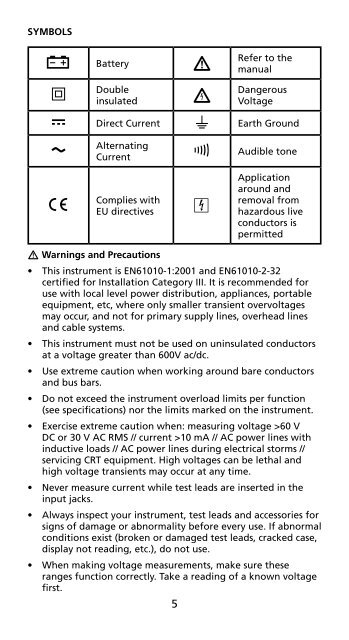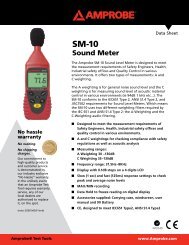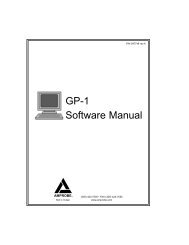AC40C AD40B - Amprobe
AC40C AD40B - Amprobe
AC40C AD40B - Amprobe
You also want an ePaper? Increase the reach of your titles
YUMPU automatically turns print PDFs into web optimized ePapers that Google loves.
Symbols<br />
Battery <br />
<br />
Double<br />
insulated<br />
<br />
Refer to the<br />
manual<br />
Dangerous<br />
Voltage<br />
Direct Current Earth Ground<br />
<br />
Alternating<br />
Current Audible tone<br />
<br />
Complies with<br />
EU directives<br />
<br />
Application<br />
around and<br />
removal from<br />
hazardous live<br />
conductors is<br />
permitted<br />
Warnings and Precautions<br />
• This instrument is EN61010-1:2001 and EN61010-2-32<br />
certified for Installation Category III. It is recommended for<br />
use with local level power distribution, appliances, portable<br />
equipment, etc, where only smaller transient overvoltages<br />
may occur, and not for primary supply lines, overhead lines<br />
and cable systems.<br />
• This instrument must not be used on uninsulated conductors<br />
at a voltage greater than 600V ac/dc.<br />
• Use extreme caution when working around bare conductors<br />
and bus bars.<br />
• Do not exceed the instrument overload limits per function<br />
(see specifications) nor the limits marked on the instrument.<br />
• Exercise extreme caution when: measuring voltage >60 V<br />
DC or 30 V AC RMS // current >10 mA // AC power lines with<br />
inductive loads // AC power lines during electrical storms //<br />
servicing CRT equipment. High voltages can be lethal and<br />
high voltage transients may occur at any time.<br />
• Never measure current while test leads are inserted in the<br />
input jacks.<br />
• Always inspect your instrument, test leads and accessories for<br />
signs of damage or abnormality before every use. If abnormal<br />
conditions exist (broken or damaged test leads, cracked case,<br />
display not reading, etc.), do not use.<br />
• When making voltage measurements, make sure these<br />
ranges function correctly. Take a reading of a known voltage<br />
first.<br />
5




